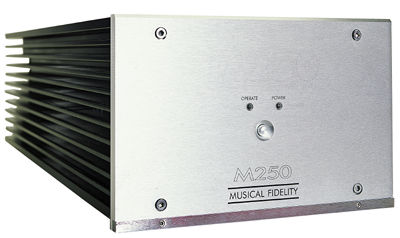Musical Fidelity M250 monoblock power amplifier

Many manufacturers now offer multichannel amplifiers in a single chassis. While these can be relatively compact, they have their own drawbacks—especially if high power is required and if the distance to the speakers is more than 10 feet. Packing multiple channels into a single chassis generates lots of heat, which often requires a fan to dissipate; and if a single power supply is used for all channels, it had better have an enormous reservoir. Better to pack independent amplifier modules and their own power supplies into a single box . . . but that usually adds even more weight. Either way, you often end up with a large, heavy, hot, and frequently underpowered package. You also lose upgrade flexibility, and if one channel fails, all of them have to go to the shop.
Arguably, the biggest drawbacks to single-chassis receivers and multichannel amps are the long runs of speaker cables required. Good cables are expensive and bulky, and having them all exit from a small plot of electronic real estate can be unsightly. But worse, as any serious audiophile will explain, long lengths of speaker cable, no matter how good, tend to degrade the sound, especially the bass. This is due to the damping factor, which has to do with an amplifier's ability to control the movement of the woofer cone. The higher the damping factor, the better the amplifier's ability to control cone movement, and thus the tighter, deeper, and more defined the bass will be.
The damping factor is defined as the ratio of the speaker's load impedance to the amplifier's output impedance. All things being equal, the higher the damping factor, the better. But the longer the run of speaker cable, the greater the resistance and the lower the damping factor.
The Monoblock Solution
One way to preserve an amplifier-speaker combo's potentially high damping factor, and thus good bass control, is to run long lengths of line-level interconnect from a preamp-processor to monoblock (single-channel) amplifiers placed close to each speaker. That's the idea behind Musical Fidelity's hefty M250. It's rated at a very powerful 250W into 8ohms, and provides substantially more power into lower impedances.
According to Musical Fidelity, the idea was to produce a “non-temperamental, bomb-proof" amplifier capable of delivering high power and sound quality comparable to those of the limited-edition Nu-Vista M3 integrated stereo amplifier, which I reviewed for Stereophile in February 2001. The M250's circuit is the same as the amplifier section of the M3, minus the choke-regulated power supply and, of course, the vacuum nuvistor tube in the input stage.
It's almost a shame to hide the M250s' attractive, brushed-aluminum boxes behind speakers or video monitors, but that's how they were intended to be used. You can set 'em and forget 'em: they can be awakened by a trigger signal at the trigger input or an audio signal entering the unbalanced RCA input. About 1mV will suffice to turn the M250 on, within 1.5 seconds or so of receiving the signal. You might think this would cut off the beginning of the music, but I found that the amp turned on when I powered up the preamp, so it wasn't a problem. In the absence of a signal, the amp will return to standby mode in 15 minutes. A trigger-loop jack permits all M250s in a system to be strung together. A signal loop output makes bi- or triamping easy, and dual sets of 5-way binding posts allow for easy biwiring. And, of course, the IEC AC jack lets you experiment with hideously expensive AC cords costing more than the amp itself. Or you can use the cord that comes with the amp.
Because placing an amplifier close to a large, vibrating box can produce sound-clouding microphonic vibrations, Musical Fidelity has paid a great deal of attention to the structural integrity of the M250's casework—something you'll appreciate when and if you're lucky enough to get your hands on an M250, or five or seven of them. The custom-tooled, extruded-aluminum case includes a pair of grooves for easy stacking, if needed. You can also place the M250 on its side, or even stand it on its faceplate.
The Long and Short Run
I began by auditioning five M250s piled in a stack next to my electronics rack. This necessitated the long speaker-cable runs that monoblocks are designed to alleviate, but I wanted to hear what the amps sounded like in my system's normal configuration before scattering them around the room. I first used the M250s with my reference Integra DTR 9.1 receiver, but I eventually decided to try a separate preamp-processor, the B&K Reference 30, which is essentially the preamp and control section of B&K's outstanding AVR307 Series II 7.1-channel receiver (reviewed in the November 2001 Guide).
- Log in or register to post comments






























































